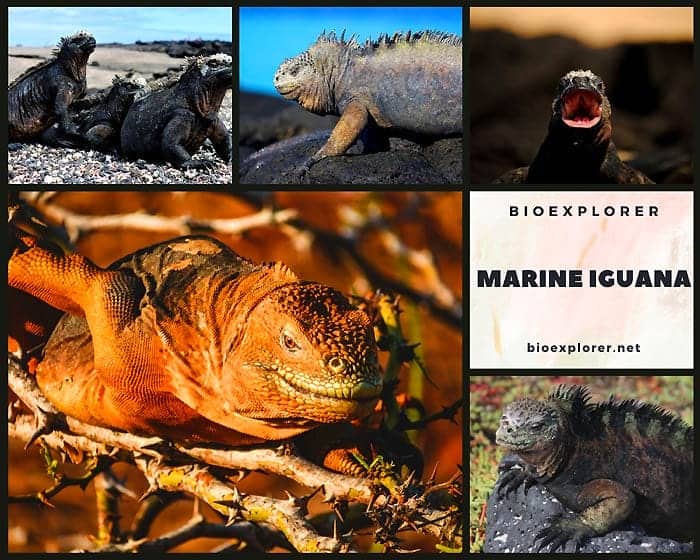
| Animalia | Squamata | Iguanidae | Amblyrhynchus | Amblyrhynchus cristatus |
The marine iguana (Amblyrhynchus cristatus) is a unique lizard found only in the Galápagos Islands of Ecuador. As the world’s only seagoing lizard, the marine iguana has evolved to adapt to the harsh marine environment over millions of years.
Marine iguanas mainly inhabit the rocky shores along the coastlines of the Galápagos Islands. They can forage in the ocean, diving underwater to feast on nutrient-rich marine Algae and seaweeds. Their physical characteristics and specialized Physiological adaptations allow them to swim and dive into frigid waters for food.
What makes the marine iguana so unique among lizards?
- They are the only lizard species in the world adapted to forage in the sea.
- Highly specialized adaptations suited for a mostly marine existence.
- Ability to safely graze underwater for extended periods without drowning.
- Capacity to take in high salt levels from marine plants and effectively eliminate excess salt.
- They play a keystone role in the Galápagos coastal ecosystem.
The marine iguana offers a striking example of evolutionary adaptation. This cold-blooded reptile has adjusted to the unique demands of the ocean environment over many generations.
This comprehensive guide will cover everything you need to know about the distinctive Galápagos marine iguana – from its evolutionary origins and taxonomic classification to its distinctive adaptations, foraging behaviors, social habits, and conservation status.
Table of Contents
- Marine Iguana Sub-Species
- Marine Iguana Physical Characteristics
- What Do Marine Iguanas Eat?
- Marine Iguana Thermoregulation Abilities
- Marine Iguana Reproduction and Social Behavior
- Marine Iguana Unique Physiology and Adaptations
- Marine Iguana Responses to Environmental Changes
- Marine Iguana Conservation Status and Threats
- Marine Iguana Fun Facts
- Frequently Asked Questions
- What unique feature distinguishes the galápagos marine iguana from other iguanas?
- How did Charles Darwin describe the galápagos marine iguana during his visit to the Galapagos Islands?
- Are marine iguanas found anywhere else besides the Galapagos islands?
- How do marine iguanas regulate their body temperature after swimming in cold water?
- What are some threats to the galápagos marine iguana’s survival?
- Can marine iguanas shrink in size? How does this affect their survival?
- What colors do marine iguanas display, and what does this tell us about their diet and breeding condition?
- How are conservation efforts supporting the survival of the galápagos marine iguana?
- Conclusion
Marine Iguana Sub-Species
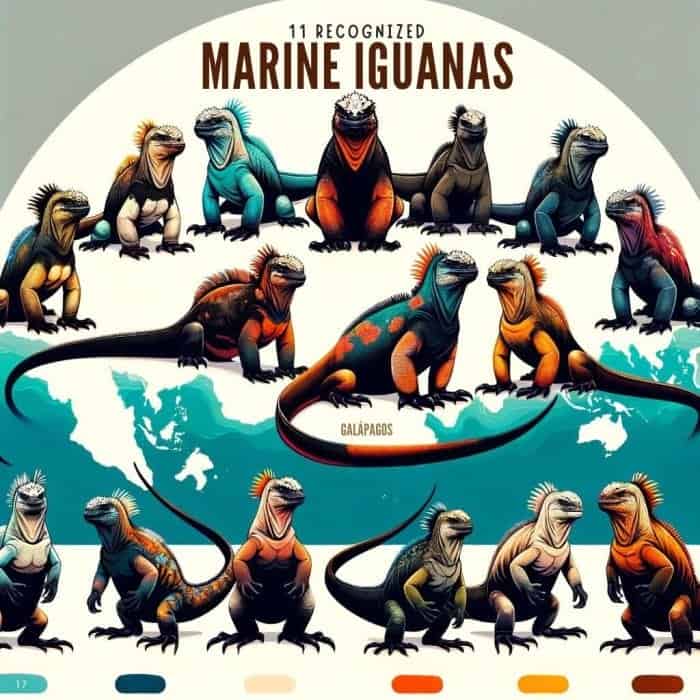
These marine creatures also called as sea iguana, saltwater iguana, or Galápagos marine iguana. There are 11 recognized subspecies of the marine iguana spread out among different islands of the Galápagos:
- A. cristatus cristatus Eastern Islands.
- A. cristatus venustissimus Isabela & Fernandina Islands.
- A. cristatus nanus Northern Isabela Island.
- A. cristatus albemarlensis Northern Isabela and Fernandina Islands.
- A. cristatus hassi Central Isabela Island.
- A. cristatus sielmanni Southern Isabela Island.
- A. cristatus mertensi Western Isabela Island.
- A. cristatus wikelskii Santiago Island.
- A. cristatus godzilla Southern San Cristóbal Island.
- A. cristatus jeffreysi Wolf Island.
- A. cristatus hayampi Marchena Island.
These subspecies vary across islands in average body length, color, crest shape, and other physical traits. Land iguanas and marine iguanas diverged evolutionarily ~10-18 million years ago.
Marine Iguana Physical Characteristics
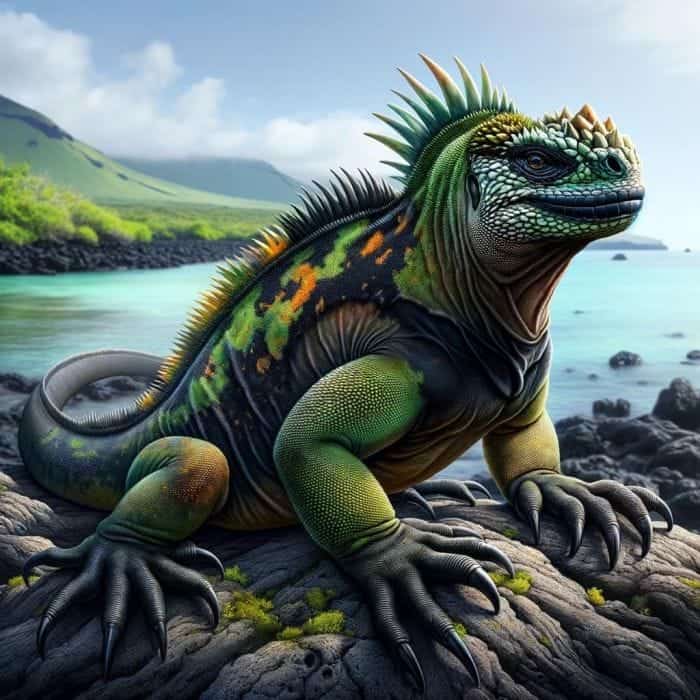
Some key physical characteristics and features that distinguish marine iguanas include:
- Flattened snout and sharp teeth for grazing algae.
- Long laterally flattened tail for swimming.
- Long, sharp claws for clinging to rocks along the shoreline.
- Salt-excreting glands on the nose to expel excess salt.
- Dark black/gray skin that absorbs heat from the sun.
Marine iguanas display stark physical differences from land iguanas:
- Land iguanas have rounded snouts, while marine iguanas have flat, sharp-toothed ones.
- Marine iguanas have a dorsal crest along their spines, which helps channel water sideways when swimming.
- Land iguanas have long, straight tails, while marine iguanas have laterally flattened tails for swimming.
Evidence also shows that hybridization occurs between marine iguana populations from different islands. This may help incorporate beneficial adaptations among subspecies over time.
What Do Marine Iguanas Eat?
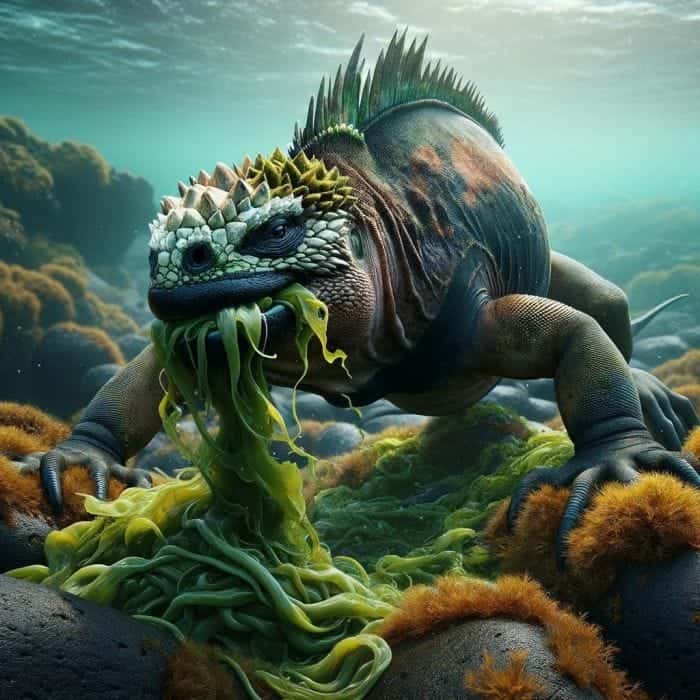
Marine iguanas are highly specialized herbivores that feed almost exclusively on nutrient-dense species of red, green, and brown marine algae and seaweeds.
These algae contain key nutrients they require, including Proteins, Lipids, Carbohydrates, vitamins, and essential minerals. Some marine vegetation-like species in the genus Sargassum have air bladders that allow them to float, requiring marine iguanas to dive beneath the surface to feed.
The specific marine algae species that comprise the core marine iguana diet include:
- Red algae: Centroceras clavulatum, Gelidium crinale, Gracilaria galapagensis.
- Green algae: Codium fusiforme, Ulva fasciata, Ulva lactuca.
- Brown algae: Laminaria taeniata, Macrocystis pyrifera, Sargassum filipendula.
Field observations indicate adult marine iguanas spend roughly 45-55% of daylight hours actively foraging at sea, depending on food availability. During prime feeding periods with abundant algae growth like La Niña events, only 30-35% of their day may be required.
Marine iguanas employ two key foraging strategies depending on the iguana’s size, age, territory, time of year, and daily tidal changes:
Intertidal Foraging
- Performed in rocky intertidal zones during low tide periods.
- Allows iguanas to stay warmer on rocks while feeding above water.
- Favored strategy of smaller, younger individuals.
Subtidal Foraging
- Swimming out and diving continuously under the water’s surface.
- Better access to more food sources subtidally than exposed at low tide.
- Used primarily by large adults and non-territorial males.
Younger iguanas tend to stick to daytime feeding in warmer mid-day temperatures when the risk of hypothermia is reduced. Meanwhile, larger adult marine iguanas will feed throughout the day depending on the tides – using any window to forage.
Marine iguanas can supplement their diet with land plants when their marine food sources become scarce during El Niño climate shifts or due to human impacts like overfishing. Their behavioral foraging adaptability allows these lizards to survive dramatic seasonal temperature and food availability swings.
Marine Iguana Thermoregulation Abilities
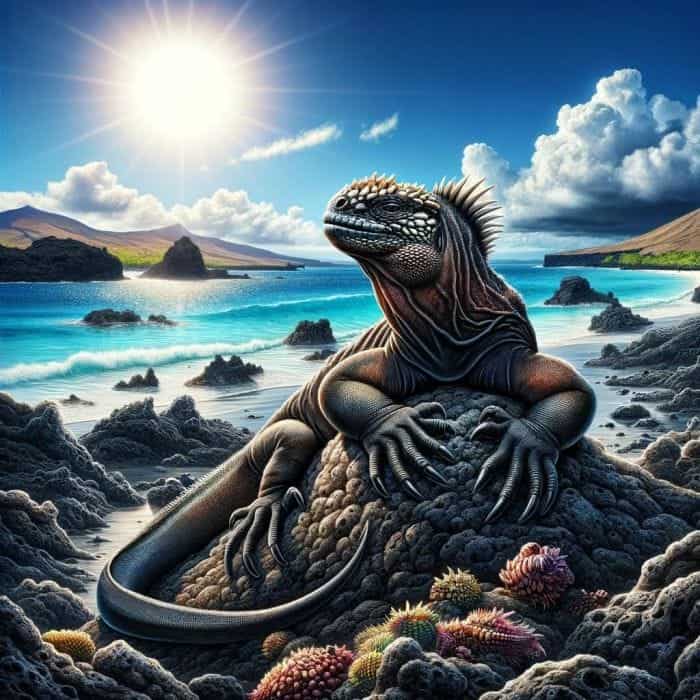
Marine iguanas employ specialized behaviors and physiological adaptations to maintain an optimal body temperature of 35-39°C while foraging in cold ocean waters.
Some of their key thermoregulation tactics include:
- Hauling out and flattening their bodies against black volcanic rocks to absorb heat.
- Clustering in aggregations to limit heat loss.
- Constricting blood flow from extremities to preserve core body heat.
- Digging shelters into sand or hiding in cracks, lava tubes, and crevices.
- Orienting side-on towards the sun’s rays with their dorsal crest exposed.
Additionally, the physical characteristics of marine iguanas play a role in thermoregulation:
- Dark black skin absorbs solar radiation to warm the body.
- Flattened dorsal spines form a crest to channel water off while swimming.
- Nasal salt glands allow marine iguanas to efficiently expel excess salt from large algae meals.
Younger iguanas have a harder time retaining body heat compared to larger adults. They rely more heavily on heat absorption from the environment and aggregating into dense clusters along the shorelines.
Meanwhile, some large adult marine iguana populations can maintain higher activity levels and bodily functions even in colder water temperatures than smaller individuals who become more lethargic.
Their adaptations and behaviors for thermoregulation are essential for the marine iguana’s survival in variable marine conditions.
Marine Iguana Reproduction and Social Behavior
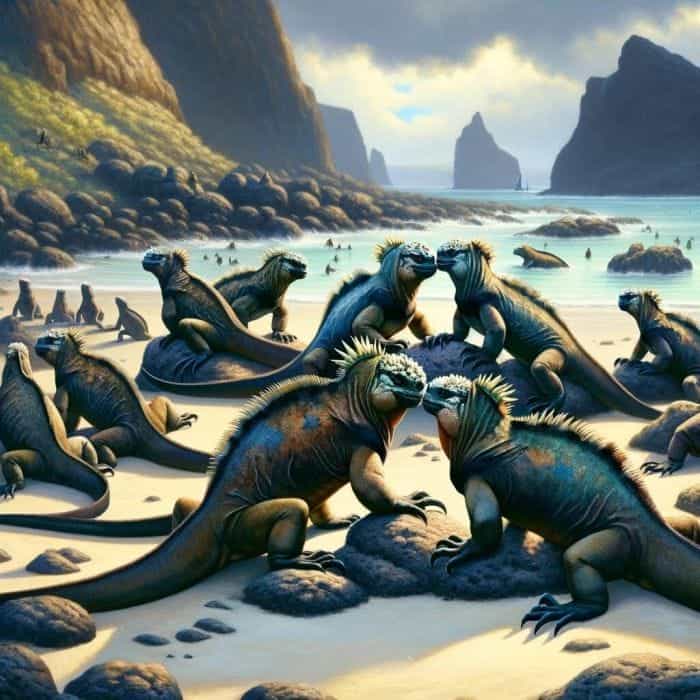
Marine iguanas have interesting reproductive behaviors and social dynamics unique among lizards:
- Mating System: Polygynous; males mate with multiple females.
- Mating Habits: Males establish clustered aggregations of females on territories for mating access.
- Breeding Season: Around January-March, depending on food availability.
- Reproduction: Females lay 2-6 eggs in sandy inland nest sites; no parental care.
Male marine iguanas are highly territorial, especially during breeding season. The larger males maintain small territories centered around a nesting area or cluster of female iguanas, aggressively keeping out other males. Displays of dominance include bobbing their heads up and down and lateral body compressions.
Interestingly, female marine iguanas appear to choose larger males with well-established nesting territories to mate with. Their ability to assess males and exert mate choice may be constrained during years with substantial food limitations.
Outside of the breeding period, marine iguanas spend a substantial portion of time aggregated into clusters along rocky shorelines. These groups serve an important purpose:
- Shared vigilance for predators like hawks and snakes.
- Social thermoregulation by cluster along the shorelines.
- Lower aggression from territorial males defending nest sites.
Their complex social dynamics and reproductive behaviors have been shaped by the extreme environments of the Galápagos over millions of years.
Marine Iguana Unique Physiology and Adaptations
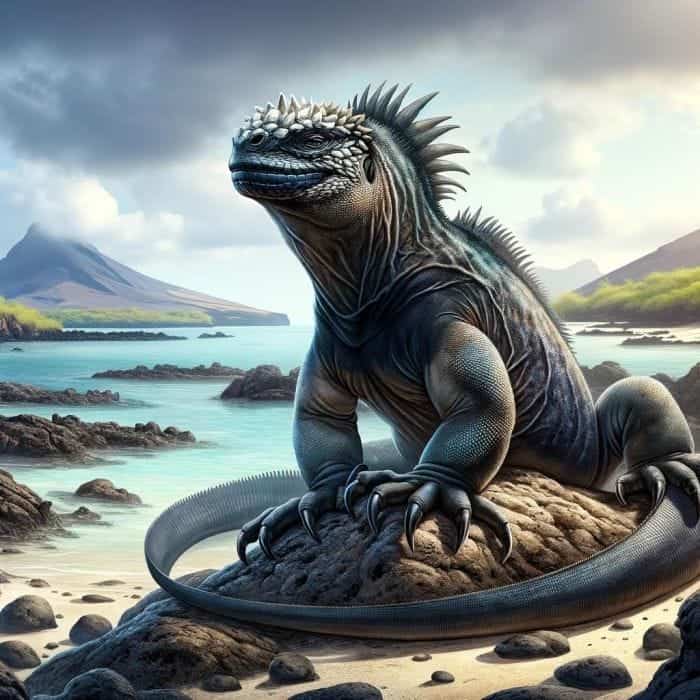
Marine iguanas have evolved an array of specialized physiological adaptations and biochemical traits that enable them to dive and graze underwater without drowning.
Specialized Salt Glands
Marine iguanas have salt glands above their nostrils that remove excess salt from the bloodstream. After feeding on marine vegetation, marine iguanas will expel concentrated salt from these nasal salt glands in a series of forceful sneezes.
Some researchers have hypothesized these salt sneezes may also serve a secondary social purpose in communication between iguanas. The frequent “achoo” sounds produced by clusters of marine iguanas along rocky shores may relay information about feeding success.
Gut Morphology and Digestion
Marine iguanas have a gut morphology well-adapted to their herbivorous marine diet. Their large intestine and colon are enlarged to allow more surface area for water reabsorption. Food passage time through the digestive tract can take 5 days or longer.
Marine iguanas also host specialized Microorganisms in their gut, including Bacteria and protozoa that assist in the breakdown and Digestion of the tough algal Cell Walls they consume. Compared to land iguanas, researchers have found marine iguana fecal samples contain a higher abundance and diversity of microbial gut symbionts.
Blood Chemistry
Marine iguanas must process and maintain higher dietary salt intake than their terrestrial counterparts. Blood samples show marine iguanas have unusually high blood sodium levels, averaging around 180 mg/dL — one of the highest known levels among lizards.
Marine iguanas also have elevated chloride, potassium, and other electrolyte concentrations compared to land iguanas. Hormones, protein, and hematological markers also differ with adaptations geared towards their marine grazing lifestyle.
Diving Specializations
During foraging dives, marine iguanas can lower their heart rate dramatically to conserve oxygen when submerged for up to 45 minutes at depths exceeding 30 feet. Their blood has a greater affinity for oxygen, allowing their tissues to extract more oxygen to sustain aerobic metabolism while underwater.
Body temperatures can drop as much as 14°C during lengthy dives, reaching as low as 21°C before they must return to land to rewarm and restore vital metabolic and physiological functioning. Vasoconstriction limits blood circulation to the extremities to prevent rapid heat loss while diving.
Marine Iguana Responses to Environmental Changes
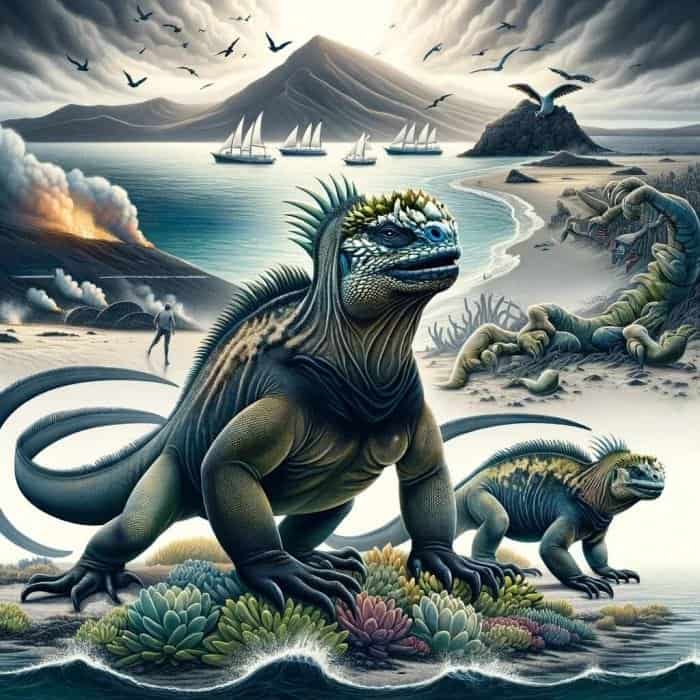
The marine iguanas of the Galápagos Islands must cope with a range of environmental fluctuations and stresses. Their ability to respond and adjust to these changes through phenotypic plasticity and rapid Evolution is essential to survival.
El Niño Southern Oscillation
Recurring El Niño climate patterns every 2 to 7 years significantly impact marine iguanas due to major reductions in intertidal and subtidal algae. During the 1997-98 El Niño, high mortality led to population declines exceeding 90% on some islands.
In response, marine iguanas have shown the ability to:
- Shrink hind leg bone length by as much as 20% to lower Energy needs.
- Supplement diet with land plants when marine resources are scarce.
- Prioritize digestion efficiency over growth in size.
Climate Change
As sea levels rise and ocean temperatures increase, the suitable intertidal algal grazing habitat available to marine iguanas may diminish. Some evidence indicates iguanas can behaviorally thermoregulate more when needed to compensate for rising temperatures.
Oil Spills
Even very small amounts of oil in marine food sources and nesting areas have proven catastrophic to marine iguana health and breeding success. An estimated 50,000-60,000 iguanas perished in the wake of the 2001 fuel spill near San Cristóbal Island. Their sensitivity makes prevention critical.
Marine iguanas’ ability to evolve rapidly has enabled them to adapt to the extreme variation and seasonal nature of the Galápagos marine environment over millions of years. However, current anthropogenic threats and environmental change rates may test this iconic species’ resilience.
Marine Iguana Conservation Status and Threats
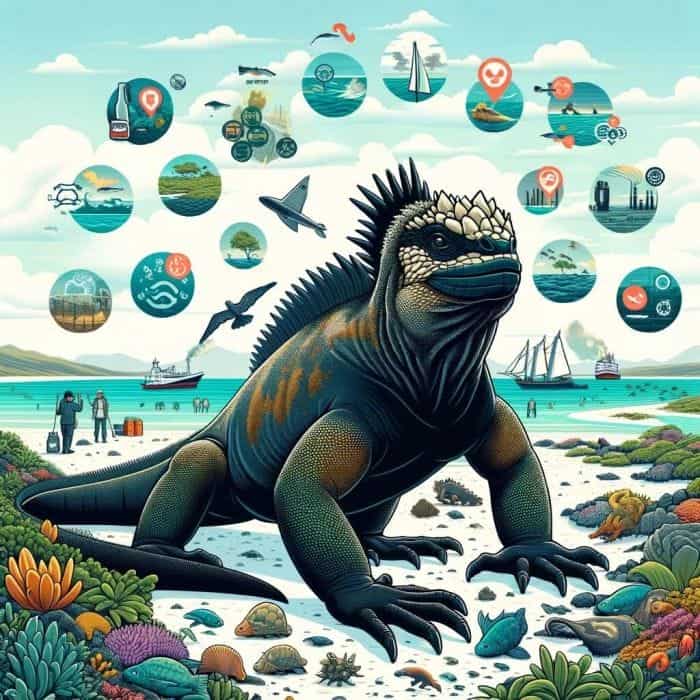
Due to ongoing threats from environmental and human impacts, the IUCN Red List classifies the marine iguana species as vulnerable with a decreasing overall population trend.
Several marine iguana subspecies are listed as endangered or critically endangered, such as the two subspecies only found on San Cristóbal Island.
Major threats and issues facing Galápagos marine iguanas include:
- Climate Changes: Rising temperatures, declining suitable intertidal feeding zones, increased weather volatility.
- Oceanic Changes: Rising sea levels, erosion of nesting sites, flooding risk.
- Oil Pollution: Extremely sensitive to even minor oil remnants in marine system.
- Overfishing: Less food supply from human overfishing of algae areas.
- Invasive Species: Predation and displacement by invasive cats, rats, and dogs.
- Habitat Loss: Coastal development, tourism impacts, nesting area depletion.
Ongoing conservation initiatives seek to preserve the unique Galápagos marine iguana by:
- Establishing protected marine reserves around islands.
- Ecological restoration programs to expand nesting sites.
- Wildlife monitoring of health and populations.
- Local education and teaching sustainable fishing practices.
- Raising awareness to avoid oil spills and discharge.
- Eradication and neutering programs for invasive predators.
- Promoting eco-tourism over development.
The distinctive marine iguana remains highly threatened as a keystone and indicator species vital to the broader coastal habitat health of the Galápagos island chain.
Marine Iguana Fun Facts
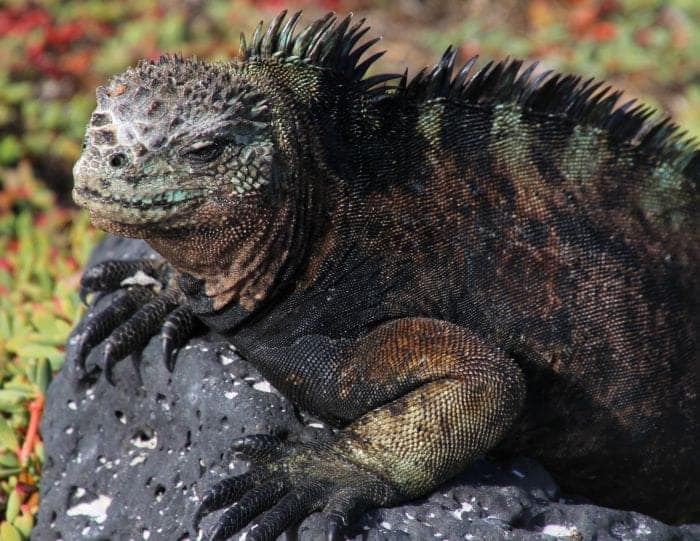
- Salty Sneezes Marine iguanas have specialized salt glands above their nostrils that filter salt from the bloodstream after ingesting salty marine vegetation. They will then forcibly expel the excess concentrated salt crystals through these nasal glands in aggressive sneezes.
- Cold Blood Marine iguanas can lower their body temperature by as much as 14°C when diving into cold ocean waters to find food without negative health impacts. This allows them to stay submerged for over 45 minutes while keeping physiological processes functioning. No other lizard species on Earth can withstand such extreme internal temperature fluctuations.
- Born to Be Wild Marine iguanas are believed to be the only modern lizard species with an exclusively herbivorous diet comprised of almost nothing but marine algae and seaweed vegetation. Their razor-sharp teeth and flat snout efficiently scrape and bite marine vegetation from rocks.
- Hang Ten Surfers Using their large, flattened rudder-like tails and sharp claws to grip rocky surfaces, marine iguanas commonly ride crashing waves onto shore when returning from ocean foraging trips. Surfing allows marine iguanas to swiftly return to land while expending far less energy.
- Disco Fever Dances Male marine iguanas battle to attract mates using elaborate visual displays, like repeatedly bobbing their bright reddish-orange colored heads up and down while laterally compressing their bodies to appear larger to competitors. Head bobbing displays also allow males to stake territory.
- Beauty and Brawn Large alpha male marine iguanas will periodically show off their strength with wrestling displays on land where they whip each other with their spiky tails and aggressively crash their bodies together in attempts to knock their competitor off balance to assert dominance in front of potential female mates.
- Sandy Secret Female marine iguanas will migrate over a mile inland from the coasts to dig holes and lay their eggs deposited in clusters buried deep under layers of sand that provide protection from temperature extremes that could endanger egg survival.
- Safety in Numbers Newly hatched baby marine iguanas emerge from their buried sandy nests in coordinated groups that can exceed over 200 offspring. They instinctively migrate in these large numbers toward the shorelines immediately while narrowly avoiding hungry racer snakes that prey on these young hatchlings.
- Cliff Divers Marine iguanas possess a reptilian version of built-in scuba gear, allowing them to plunge to depths exceeding 30+ feet below the ocean surface thanks to special adaptations like constricting blood flow, filtering oxygen, and slowing their heart rate. The largest marine iguanas can hold their breath for nearly one hour while grazing for marine vegetation underwater.
- Shrinking Superpower When the critical marine algae marine iguanas rely on become scarce due to El Niño climate changes shifting ocean conditions, they are capable of instantaneously altering their bone structure to shrink over 20% in length to radically reduce their energy needs to boost survival probabilities until marine vegetation can recover.
Frequently Asked Questions
What unique feature distinguishes the galápagos marine iguana from other iguanas?
Marine iguanas are the only lizards that can forage in the sea. They feed on algae, which they most commonly find along the rocky Galapagos shorelines or by diving into the ocean.
How did Charles Darwin describe the galápagos marine iguana during his visit to the Galapagos Islands?
Charles Darwin famously described the galápagos marine iguana as “imps of darkness” due to their black coloration and unique marine lifestyle, unlike any other reptile he had observed.
Are marine iguanas found anywhere else besides the Galapagos islands?
No, marine iguanas are endemic to the Galapagos Islands. This means they are found nowhere else, making them one of the many unique species contributing to the islands’ exceptional biodiversity.
How do marine iguanas regulate their body temperature after swimming in cold water?
After swimming, marine iguanas bask in the sun on the volcanic rocks of the Galapagos Islands. This behavior allows them to absorb heat and regulate their body temperature, crucial for survival in the cold oceanic environment.
What are some threats to the galápagos marine iguana’s survival?
The primary threats to marine iguanas include habitat destruction, pollution, and the introduction of feral predators to the Galapagos Islands. These introduced predators, such as dogs and cats, often prey on iguanas or compete with them for food resources.
Can marine iguanas shrink in size? How does this affect their survival?
Research has shown that marine iguanas can shrink their body size by as much as 20% during food shortages. This adaptation helps them survive periods of scarcity, as a smaller body size requires less energy.
What colors do marine iguanas display, and what does this tell us about their diet and breeding condition?
Marine iguanas can display various colors, from black and dark grey to vibrant hues of red and green, especially during the breeding season. The red and green colors are typically more pronounced in iguanas that feed on algae rich in carotenoids, indicating their healthy diet and readiness for breeding.
How are conservation efforts supporting the survival of the galápagos marine iguana?
Conservation efforts for marine iguanas include habitat restoration, control and eradication of introduced predators, and better research to understand the population biology of marine iguanas. These efforts aim to protect marine iguanas and ensure their continued survival in the Galapagos Islands.
Conclusion
As the only seagoing lizard on Earth, the Galápagos marine iguana remains unique. Their specialized adaptations and complex lifecycle living along the extreme shorelines of the Galápagos provide researchers with continued mysteries to solve.
Marine iguanas play an essential role within the greater coastal and marine ecosystem dynamics of the Galápagos Islands. Protecting their inland nesting sites and coastal marine feeding areas is key to their future viability. As a key indicator species, their health and abundance signal the greater stability of the Archipelago.
While major threats from climate change, oceanic changes, oil pollution, and invasive species continue to impact marine iguanas, researchers remain hopeful that this resilient species will continue to overcome environmental challenges as they have for millennia – through phenotypic plasticity, behavioral changes, or Genetic evolutionary shifts. Their continued persistence will depend on comprehensive conservation initiatives focused on this iconic and beloved lizard.











